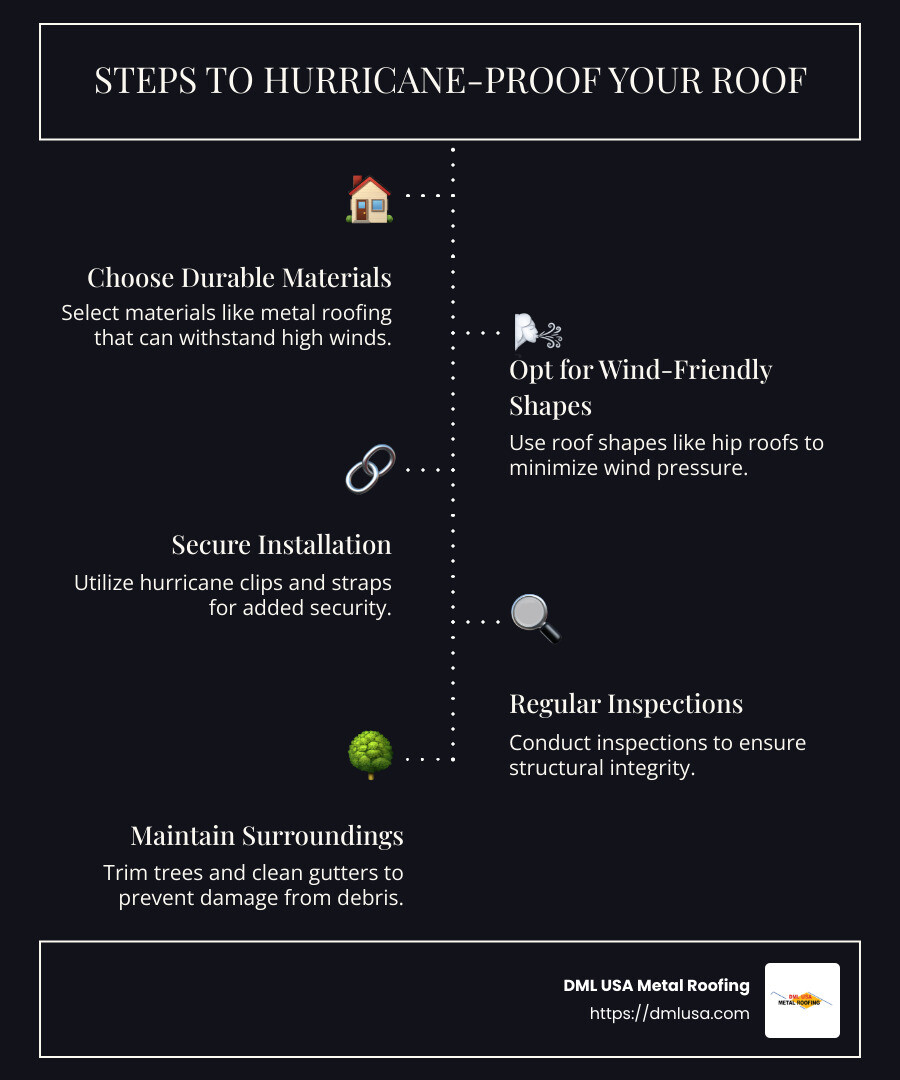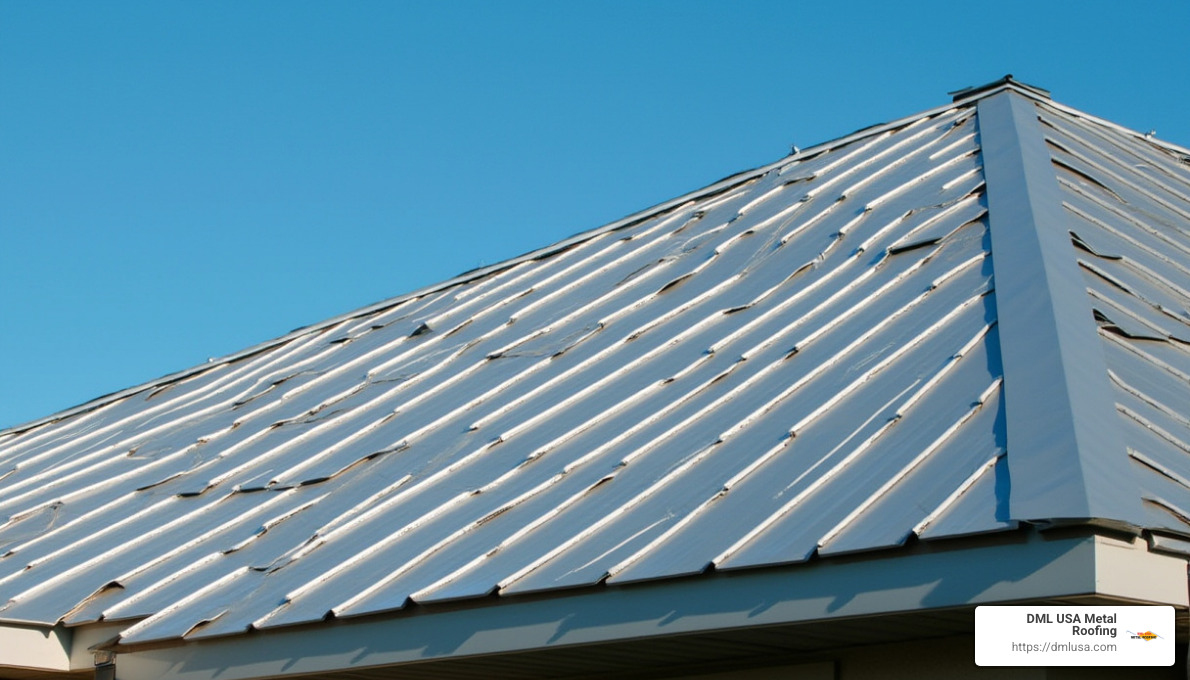When considering hurricane proof roofs, focus on materials and designs that withstand extreme weather conditions. Here’s a quick rundown:
- Durability: Opt for materials known for withstanding high winds, like metal roofing.
- Roof Shape: Choose a shape that minimizes wind pressure, such as a hip roof.
- Installation: Ensure your roof is secured with hurricane clips and straps.
Hurricane dangers are numerous and severe. They bring high winds, sometimes exceeding 100 mph, which can rip roofing materials off homes. This, in turn, can send shingles and tiles flying, posing significant hazards. Flying debris and intense rainfall add to the risk, potentially causing leaks and structural damage.
Flooding poses another threat, where storm surges can undermine your home’s foundation. For homeowners, ensuring your roof’s integrity is not just about preservation but about safety and peace of mind.
I’m Adam Kadziola. From years of experience in metal roofing manufacturing, I’ve witnessed the transformative power of hurricane proof roofs and their role in safeguarding homes from harsh weather. Join me as we dig deeper into the best strategies to protect your home from hurricanes.

Understanding Hurricane-Proof Roofs
When it comes to hurricane proof roofs, understanding key design elements can make all the difference. Let’s break down what makes a roof resilient against the fierce forces of a hurricane.
Wind Resistance
The primary concern during a hurricane is wind resistance. Roofs must withstand sustained winds that can easily exceed 100 mph. To achieve this, the roof’s shape and materials play a crucial role. Metal roofing, for example, is known for its exceptional wind resistance. It can endure gusts up to 120 mph, providing a sturdy defense against the elements.
Roof Shape
Not all roof shapes are created equal when facing hurricane conditions. A hip roof is often considered the most hurricane-resistant design. Its four slopes allow wind to pass over more smoothly, reducing pressure on any single area. In contrast, gable roofs may catch the wind like a sail, increasing the risk of damage.
Roof Slope
The slope of your roof also impacts its ability to withstand high winds. A 30-degree slope is ideal, as it helps deflect wind and reduces uplift pressure. This angle strikes a balance between aesthetics and functionality, providing a traditional look while enhancing wind resistance.
Pressure Strategy
Managing wind pressure is critical. Roofs with minimal eaves—ideally no more than 20 inches—experience less uplift pressure. Additionally, incorporating a central shaft that connects the roof ridge with the interior space can help balance pressure and prevent the roof from being blown off.
Egress Points
All points of egress, such as doors, windows, and vents, must be fortified as part of a comprehensive hurricane-proof strategy. These areas are vulnerable to uplift pressures and should be adequately protected to prevent breaches that can lead to significant damage.
By focusing on these elements, you can help ensure your roof is ready to face the challenges of hurricane season. Next, we’ll explore the best materials for constructing hurricane-proof roofs.
Best Roofing Materials for Hurricane-Prone Areas
Choosing the right materials for your roof is crucial when living in hurricane-prone areas. Each material has its pros and cons, and understanding these can help you make the best decision for your home.
Metal Roofing
Metal roofing stands out as the top choice for hurricane proof roofs. It’s incredibly durable and can withstand winds up to 120 mph. Metal roofs are also fire-resistant, making them a safe choice during storms that might cause fires from downed power lines. The two main types of metal roofing are standing seam and corrugated metal. Both offer excellent protection, but standing seam designs are especially effective at shedding water and debris, reducing the risk of leaks.

Concrete Tiles
Concrete tiles are another strong contender. They are heavy and durable, which helps them stay put during high winds. However, their weight requires a robust roof structure, so they might not be suitable for all homes. Concrete tiles are also resistant to fire and can last for many years with proper maintenance.
Clay Tiles
Clay tiles offer a similar level of durability as concrete tiles. They are heavy and can withstand strong winds if properly installed. Clay tiles are also fire-resistant, which is a plus in hurricane-prone areas. However, like concrete, their weight can be a drawback, and they may not be suitable for every roof structure.
Asphalt Shingles
Asphalt shingles are a popular choice due to their affordability and ease of installation. While they can withstand winds over 100 mph, they are less durable than metal or tile options. To improve their performance in hurricanes, it’s important to reinforce them with hurricane-proof straps or clips. Some specialized asphalt shingles, like the GAF AS II, are designed for better impact resistance.
Wood Shakes
Wood shakes are less common but can be surprisingly resilient in hurricanes. They can resist winds up to 200 mph when installed correctly. However, they are labor-intensive to install and maintain. Wood shakes are also susceptible to fire and insect damage, so they require regular upkeep and treatment with protective sealants.
Each roofing material has its strengths and weaknesses, and the best choice depends on your specific needs and budget. In the next section, we’ll dig deeper into why metal roofing is considered the elite choice for hurricane-proof roofs.
Metal Roofing: The Elite Choice for Hurricane-Proof Roofs
When it comes to hurricane proof roofs, metal roofing is in a class of its own. Its combination of durability, fire resistance, and wind resistance makes it an ideal choice for homes in hurricane-prone areas.
Durability
Metal roofs are built to last. They can withstand harsh weather conditions, including heavy rain, hail, and high winds. With a lifespan that can exceed 50 years, metal roofing offers long-term protection and peace of mind for homeowners. Plus, the materials used, like aluminum and galvanized steel, are resistant to rust and corrosion, ensuring that your roof remains strong over time.
Fire Resistance
Another key advantage of metal roofing is its fire resistance. Unlike wood or asphalt shingles, metal roofs are non-combustible. This means they won’t catch fire from embers or sparks, providing an extra layer of safety during storms that might cause fires from downed power lines.

Wind Resistance
Metal roofs excel in wind resistance, a crucial feature for surviving hurricanes. Designed to withstand wind gusts up to 120 mph, they outperform many other roofing materials. Standing seam metal roofs, in particular, are engineered to reduce wind uplift by allowing wind to flow smoothly over their surface. This design minimizes the risk of panels coming loose during a storm.
Types of Metal Roofing
There are two main types of metal roofing: standing seam and corrugated metal. Each offers unique benefits:
Standing Seam: This design features vertical seams that lock together, providing improved protection against water and debris. Its sleek appearance also adds a modern touch to any home.
Corrugated Metal: Known for its wave-like pattern, corrugated metal roofing is both strong and cost-effective. It’s often made from galvanized steel or aluminum, both of which offer excellent durability and weather resistance.
Material Choices
When choosing metal roofing, homeowners have several material options. Aluminum is lightweight and resistant to corrosion, making it a great choice for coastal areas. Galvanized steel offers robust strength and is often coated with protective finishes to improve its longevity. Both materials can be customized with various coatings and colors to match your home’s aesthetic.
In summary, metal roofing is a top-tier choice for those seeking a hurricane proof roof. Its blend of durability, fire resistance, and wind resistance, along with versatile design options, makes it an investment worth considering for any homeowner in a hurricane-prone area.
Next, we’ll explore how to design the most hurricane-resistant roof, focusing on roof shapes, slopes, and other critical factors.
Designing the Most Hurricane-Resistant Roof
When it comes to creating a hurricane-proof roof, design plays a crucial role. The shape, slope, and overhang of your roof can significantly affect its ability to withstand high winds and flying debris during a hurricane.
Hip Roof
A hip roof is one of the most effective designs for hurricane resistance. It features four sloping sides that come together at the top, forming a ridge. This design allows wind to flow over the roof smoothly, reducing the risk of uplift. The absence of flat surfaces or sharp edges minimizes wind pressure, making hip roofs a top choice for hurricane-prone areas.
Gable Roof
While the gable roof is popular for its traditional appearance, it is less wind-resistant than a hip roof. Gable roofs have two sloping sides that form a triangle, which can catch the wind more easily. If you prefer this design, consider reinforcing it with additional bracing and hurricane straps to improve its resilience against strong winds.
Flat Roof
Flat roofs are not ideal for hurricane-prone regions. Their horizontal surface can create significant wind uplift, making them vulnerable during storms. If a flat roof is necessary, ensure it is properly reinforced and regularly maintained to minimize risks.
Shed Roof
A shed roof has a single slope and is often used for smaller structures. However, it offers limited wind resistance and is not recommended for areas frequently hit by hurricanes. If you have a shed roof, consider upgrading to a more aerodynamic design, like a hip roof, to better protect your home.
Roof Overhang
The roof overhang can also impact wind resistance. Large overhangs are susceptible to wind uplift, which can cause damage during a hurricane. To reduce this risk, keep overhangs minimal, ideally under 20 inches, and reinforce them with strong materials.
Roof Pitch
The roof pitch, or the steepness of the roof, affects how wind travels over it. A pitch of around 30 degrees is considered optimal for minimizing wind pressure and maximizing stability. This angle allows wind to glide over the roof rather than pushing against it.
By carefully considering these design elements, you can significantly improve your roof’s ability to withstand hurricane conditions. Next, we’ll discuss how to prepare your roof for hurricane season, including essential maintenance and reinforcement strategies.
Preparing Your Roof for Hurricane Season
Getting your roof ready for hurricane season is crucial to protect your home from potential damage. Here’s a simple guide to help you ensure your roof is in the best shape possible before the storms hit.
Roof Inspection
Start with a roof inspection. This is your first line of defense against hurricane damage. A professional inspection can spot loose or missing shingles, leaks, and other vulnerabilities. Catching these issues early means you can fix them before they become a bigger problem during a storm.
Hurricane Straps and Roof Reinforcements
Next, consider installing hurricane straps. These metal connectors help keep your roof attached to the walls of your home during high winds. They’re especially important if your home was built before modern building codes required them. Reinforcing your roof with these straps can make a big difference in its ability to withstand a hurricane.
You can also add roof reinforcements like extra bracing or clips. These additions provide additional support to your roof structure, making it more resilient against wind uplift and flying debris.
Gutter Cleaning
Don’t forget to clean your gutters. Clogged gutters can cause water to back up onto your roof, leading to leaks and water damage. Before hurricane season, clear out leaves, twigs, and other debris to ensure water can flow freely away from your home.
Tree Trimming
Finally, take a look at the trees around your home. Tree trimming is a simple yet effective way to reduce the risk of branches breaking off and damaging your roof. Trim any dead or overhanging branches to prevent them from becoming dangerous projectiles during a hurricane.
By following these steps, you can help ensure your roof is ready for the challenges of hurricane season. Up next, we’ll answer some common questions about hurricane-proof roofs, including the best roof shapes and materials for hurricane-prone areas.
Frequently Asked Questions about Hurricane-Proof Roofs
What is the best roof shape for hurricanes?
When it comes to hurricane-proof roofs, the shape of your roof plays a crucial role in its ability to withstand high winds. The most effective roof shape is a hip roof. This design features four sloping sides, which helps to reduce wind pressure on any single part of the roof. Hip roofs are more aerodynamic, allowing wind to flow over them smoothly, minimizing the risk of damage.
In contrast, a gable roof with its two steep slopes can catch the wind like a sail, making it more susceptible to damage during a hurricane.
How can I reinforce my existing roof?
Reinforcing your existing roof is a smart way to improve its durability during hurricane season. Here are a few ways to do it:
Install hurricane straps: These metal connectors attach the roof to the walls, providing extra stability against wind uplift.
Add roof clips or braces: These reinforcements support the roof structure, making it more resistant to flying debris and high winds.
Upgrade the underlayment: Use a high-quality membrane beneath your roofing material to prevent leaks and water damage.
Limit roof overhangs: Keep overhangs under 20 inches to reduce wind uplift pressure.
Taking these steps can significantly improve your roof’s resilience, even if it wasn’t initially designed to withstand hurricanes.
Are metal roofs the best option for hurricanes?
Yes, metal roofs are often considered the best option for hurricane-prone areas. Here’s why:
Durability: Metal roofs can withstand winds up to 120 mph, making them highly resistant to hurricane-force winds.
Fire resistance: Metal is a noncombustible material, providing excellent protection against fires that may occur during a storm.
Lightweight: Unlike heavier materials like concrete tiles, metal roofs are lighter, reducing the risk of structural damage during an earthquake or hurricane.
Energy efficiency: Reflective metal roofing can save up to 40% in energy costs by keeping your home cooler, which is a bonus in hot climates.
With these benefits, metal roofs not only protect your home during a hurricane but also offer long-term savings and peace of mind.
In the next section, we’ll wrap up with how investing in a quality roof, like those offered by DML USA Metal Roofing, can provide lasting protection and value for your home.
Conclusion
Investing in a quality roof is one of the smartest decisions you can make for your home, especially in hurricane-prone areas. At DML USA Metal Roofing, we understand the importance of combining durability with peace of mind. Our metal roofing solutions are designed to withstand the harshest weather conditions, including hurricane-force winds.
Why Choose DML USA Metal Roofing?
Quality and Durability: Our metal roofs can endure winds up to 120 mph, ensuring that your home stays protected during the fiercest storms. With a 50-year warranty, you can trust in the long-lasting performance of our products.
Peace of Mind: Knowing your roof is made from noncombustible materials provides added security against fires, which can be a concern during hurricanes. Our roofs are also lightweight, reducing the risk of structural damage.
Long-Term Savings: Reflective metal roofing can save you up to 40% on energy costs by keeping your home cooler. Plus, the durability of our roofs means less maintenance and repair costs over time.
Choosing a hurricane-proof roof from DML USA Metal Roofing is not just an investment in your home, but also in your peace of mind. With our high-quality, affordable solutions, you can face hurricane season with confidence.
For more information about our products and how they can protect your home, visit our DML USA Metal Roofing products page.

